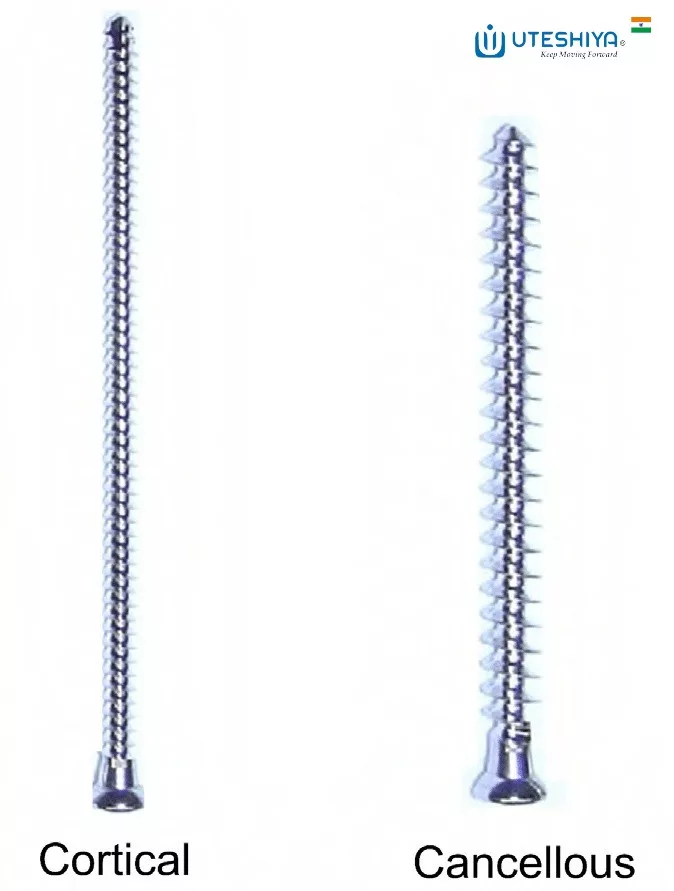
Screws are critical components used in orthopedic surgery for bone fixation and implant stability. Cortical screws and cancellous screws are two popular types of screws used in these treatments. Each screw type has unique properties and applications.
Different Types of Screws
Orthopedic surgeons have a variety of screw alternatives at their disposal, each customized to meet unique clinical needs. Cortical screws and cancellous screws are two of the most commonly used choices due to their special features and versatility.
Cortical Screws
Cortical screws are typically used to secure the thick cortical bone.
These screws have a small thread pitch and a greater core diameter, making them ideal for cortical bone stability and fixation. They can be utilized in procedures that involve long bones such as the femur, tibia, and humerus.
Key characteristics of cortical screws
Thread design
Cortical screws are identified by their small thread depth and aggressive pitch. This shape enables them to firmly engage in the dense cortical bone, providing good purchase and stability.
Core diameter
When compared with cancellous screws, cortical screws have a wider core diameter. Because of their wider diameter, they have greater strength and resistance to shear pressures, making them suited for load-bearing applications.
Length
Cortical screws come in a variety of lengths to fit varying bone depths. Surgeons can choose the right screw length based on the procedure’s requirements.
Self-tapping capability
Many cortical screws are self-tapping, meaning they can drill their own pilot hole when inserted. This innovation eliminates the need for pre-drilling and streamlines the surgical procedure.
Cancellous Screws
Cancellous bone is the spongy interior substance found at the ends of long bones, in vertebral bodies, and in some fractures. Cancellous screws are intended for use in thinner cancellous bone. Cancellous screws feature a more significant thread pitch and a smaller core diameter than cortical screws, allowing them to contact the softer cancellous bone more efficiently.
Key characteristics of cancellous screws
Thread design
Cancellous screws have a more significant thread pitch and a deeper thread. This design improves purchase and engagement in the porous structure of cancellous bone, resulting in stability.
Core diameter
Cancellous screws have a smaller core diameter than cortical screws, corresponding to the reduced density of cancellous bone. This design makes it easier to adjust to the softer bone structure.
Length
Cancellous screws, like cortical screws, come in various lengths, allowing surgeons to accommodate varying bone depths.
Pre-drilling requirement
When employing cancellous screws, pre-drilling is usually required. Pre-drilling ensures precise screw placement and lowers the risk of bone fracture during screw insertion.
Difference between Cortical Screws and Cancellous Screws
While both cortical screws and cancellous screws perform essential functions, there are a few basics that separate them:
Bone structure
Cortical screws are intended for dense cortical bone, but cancellous screws are for less dense cancellous bone.
Thread design
Cortical screws feature a lower thread depth and a more aggressive pitch, allowing them to engage well in cortical bone. Cancellous screws, on the other hand, have a deeper thread with a more excellent pitch, providing better purchase in the porous structure of the cancellous bone.
Self-tapping vs. pre-drilling
Cortical screws are frequently self-tapping, which means they may drill their pilot hole while inserted. This function eliminates pre-drilling, resulting in a more efficient technique. Cancellous screws, on the other hand, often need pre-drilling to ensure appropriate placement and reduce the chance of bone fractures.
Surgical applications
Cortical screws are often employed in load-bearing situations where robust fixation is required, such as mending fractures in long bones, due to their properties. They give good cortical bone stability and support. Cancellous screws, with their broader thread pitch and smaller core diameter, are ideal for use in areas with low bone density, such as vertebral bodies or the extremities of long bones.
It is worth noting that improvements to surgical procedures and implant designs have resulted in the creation of customized screws that combine characteristics of cortical and cancellous screws. Variable pitch screws, for example, combine aggressive thread design for cortical engagement with a broader pitch for more excellent purchase in cancellous bone. Self-drilling and self-tapping screws further simplify the surgical process by eliminating the need for additional drilling.
Conclusion
Understanding the variations between cortical screws and cancellous screws can be crucial for orthopedic surgeons and other medical professionals who perform bone fixation treatments. Because of differences in thread design, core diameter, and compatibility with varied bone densities, each screw type is best suited for a particular use.
Surgeons can make informed selections when selecting the proper screw type by carefully analyzing parameters such as bone type, thread design, core diameter, and the need for pre-drilling. This decision is critical for patients’ optimal stability, fixation, and effective outcomes.

